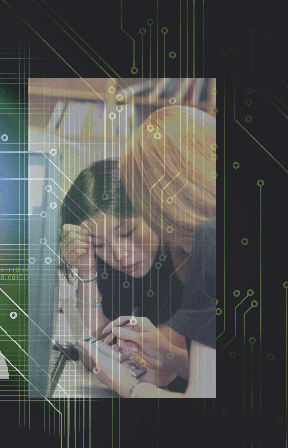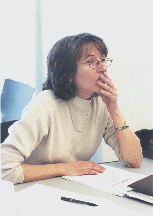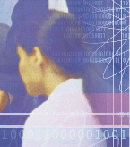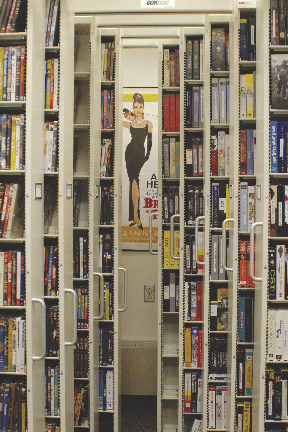|
Home, smart home
Computer science students are developing
technology that we won't be able to live without in the houses of tomorrow.
 Lisa
Burnell can visualize the home of the future. She walks in the door, speaks
a few commands and magic happens. The stereo cues her favorite compact
disc, the television clicks on her usual news station and the lights dim.
All she has to do is relax, maybe put her feet up. Lisa
Burnell can visualize the home of the future. She walks in the door, speaks
a few commands and magic happens. The stereo cues her favorite compact
disc, the television clicks on her usual news station and the lights dim.
All she has to do is relax, maybe put her feet up.
In the kitchen,
the pantry is stocked because last week the computer reminded her what
was running low and started a grocery list. For tonight, the oven is preheated
and a couple of suggested recipes for the evening meal are printed out
and ready to be prepared.
Welcome to
the "smart" home of the future, where appliances and electronics are interconnected,
voice-activated and programmed to remember entertainment, dining and lifestyle
habits. Even George Jetson never had it this good.
"Basically,
smart home technology adapts to you, not you to it," says Burnell, an
assistant professor of computer science. And it's all coming in the not-too-distant
future because of students like Burnell's who are developing the technology.
For the past two years, teams of two to four undergraduates in her Computer
Science Senior Design class have devoted their senior year to writing
programs for speech and graphic interface and intelligent learning modules
to control household electronics and manage parts of a house.
The twist
is that the project is simply too large for a single year. Or two. So
each year, students reach a stopping point at the end of the spring semester
and leave the work for the next class to resume. By project completion,
dozens of students will have added pieces to the whole.
 "It's
great training for real life," Burnell says. "Not only do they
have to pick up and understand someone else's project and read the programs,
they also have to find solutions for problems they inherited and advance
the project in a way that the next group can understand it." "It's
great training for real life," Burnell says. "Not only do they
have to pick up and understand someone else's project and read the programs,
they also have to find solutions for problems they inherited and advance
the project in a way that the next group can understand it."
In 2001,
four groups developed the first two projects from scratch -- the smart entertainment
control system (SECS), and Morpheus, a program employing infrared signals,
a speech interface and a limited learning function to identify users'
patterns. Accessed through a PDA or personal computer and a user can control
a television from anywhere.
This year,
two groups advanced the smart home project. One combined SECS and Morpheus
to create the glorified house controller (GHC), which can operate multiple
electronic devices, and reprogrammed the speech interface. Along the way,
the team debugged the learning module, enabling it to remember more user
patterns.
"Now, it
will identify that you watch The Simpsons every week and will immediately
turn the TV to the right channel when that program comes on," says computer
science senior Camille Wall, who got a head start on the class at shared
research sessions at the University of Texas at Arlington last summer.
Another measurable
step was an improved 3-D visual simulator, which helps students see how
their technology will react in a house. "For example, as we develop sensors
that detect movement in the house, they'll be able to distinguish between
a husband and wife," Wall says. "And we can test to see how the software
is supposed to work before the hardware is built."
The second
group began creating a smart home module for the kitchen. It uses a graphical
user interface, such as a PDA, to help with inventory control, storage,
reordering, recipe access and meal planning. The smart kitchen also has
a learning function that will recall food preferences, allergies and ratings.
 "Let's
say your spouse calls and says the boss and his wife are coming home for
dinner," says computer science senior Joshua Chlapek. "You know
he is on a salt-restrictive diet and she is lactose intolerant, so you
can ask the smart kitchen to retrieve a menu plan that satisfies those
constraints." "Let's
say your spouse calls and says the boss and his wife are coming home for
dinner," says computer science senior Joshua Chlapek. "You know
he is on a salt-restrictive diet and she is lactose intolerant, so you
can ask the smart kitchen to retrieve a menu plan that satisfies those
constraints."
As the computer
science department grows, so will the smart home projects, Burnell says.
It has already received a grant from TXU, which pays for two research
assistants to study different methods for predicting inhabitant behavior,
and another from the National Science Foundation, which funds two student
researchers who will study how to fit the smart home projects under one
umbrella system.
The NSF grant,
shared with the UTA computer science and engineering department, also
will be used to develop curriculum for advanced smart home courses.
The ultimate
goal, Burnell says, is a collaborative technologies course that could
be co-taught by TCU and UTA through distance education. "Obviously we're
interested in the cool engineering and a project leading to an actual
product that can be taken to the marketplace. But even more important
is the learning opportunity. These projects don't have an easy solution.
"The teacher
doesn't have all the answers. But that's part of the fun. The students
get to figure it out."
Contact
Burnell at l.burnell@tcu.edu.

Woman's world
In developing economies, women entrepreneurs
are on the up and up.
Think entrepreneur.
Do famous men come to mind? In the United States, they do. But management
professor Stephen Mueller finds that in developing countries it's the
women who are most likely to tackle entrepreneurial endeavors.
 A
recent study conducted by Mueller explored the motivating factors for
women and men in starting a business. He analyzed survey results from
university students in 17 countries for the characteristics that lead
people to start businesses, including "propensity to take risks,
innovativeness and feelings of being in control of one's fate." A
recent study conducted by Mueller explored the motivating factors for
women and men in starting a business. He analyzed survey results from
university students in 17 countries for the characteristics that lead
people to start businesses, including "propensity to take risks,
innovativeness and feelings of being in control of one's fate."
In industrialized
countries like Canada, Belgium and the United States, men were more likely
to show entrepreneurial traits. Not so in countries with developing economies
such as Croatia, the Czech Republic and Russia.
"The research
really doesn't answer why there seems to be a bigger gender gap in many
developed countries," Mueller said. But he noted that women in countries
with developed economic systems must contend with "well-established networks
of business relationships in which being an independent business owner
is still perceived as primarily a male role."
Developing
countries have fewer business traditions and "career stereotypes," so
women and men entrepreneurs seem to start on equal footing, he said. Women
in developing countries also have more freedom to "make their own history."
Mueller's
work was recognized with the inaugural Best Women's Entrepreneurship Paper
award by the Center for Women's Business Research, a national organization
devoted to increasing the understanding of cultural and gender issues
in entrepreneurship.
Contact
Mueller at s.mueller@tcu.edu.

To catch an e-thief
Fighting online crime is as big as, well,
the Internet.
The long
arm of the law doesn't quite reach online crime, according to a new  study.
The growing use of online shopping, auctions and investing services has
made online fraud an increasingly serious problem. Unfortunately police
often lack the resources and jurisdiction to effectively investigate and
prosecute the offenses. study.
The growing use of online shopping, auctions and investing services has
made online fraud an increasingly serious problem. Unfortunately police
often lack the resources and jurisdiction to effectively investigate and
prosecute the offenses.
Ronald Burns
and Keith Whitworth of TCU's department of sociology, criminal justice
and anthropology did some investigating of their own and found that "those
involved in investigating and prosecuting Internet fraud feel they lack
the staff, tools and training to do their jobs effectively," said Burns.
The professors surveyed more than 2,300 law enforcement agencies nationwide
to determine how prepared they are to deal with crimes involving online
fraud.
The study,
supported by the National White Collar Crime Center, revealed that a question
about who is going to lead the fight exists among law enforcement agencies,
according to Whitworth. Because online crime can take place in multiple
cities and states, "there is a strong feeling that federal law enforcement
should be dealing with these crimes," he said.
Burns and
Whitworth's study concluded that the attack on the problem is being conducted
"in piecemeal fashion," Whitworth said. "We need to address jurisdictional
issues É and provide the necessary resources at the state and local levels."
Contact
Burns at r.burns@tcu.edu and Whitworth at k.whitworth@tcu.edu.

Lights, camera ... Library!
Got a hankering
for an old movie? A classic cartoon? An obscure foreign title that no
one's ever heard of? Then drop by the Gwendolyn P. Tandy Memorial Film
Library, home to more than 11,500 titles in all formats.
 Founded
20 years ago by a gift from TCU parent and film fanatic Jesse Upchurch,
who continues yearly support, the library has grown into one of the most
complete collections of its kind. Feature films, documentaries, TV shows,
animated films and commercials make up the library's extensive collection
of VHS, DVD, laser disc and 16-millimeter films. Founded
20 years ago by a gift from TCU parent and film fanatic Jesse Upchurch,
who continues yearly support, the library has grown into one of the most
complete collections of its kind. Feature films, documentaries, TV shows,
animated films and commercials make up the library's extensive collection
of VHS, DVD, laser disc and 16-millimeter films.
Each year
curator Joan McGettigan, an RTVF assistant professor, adds current titles
and buys recommendations from specialists in the department. But her passion
is searching out obscure titles. "I look everywhere," she said, "from
eBay to the individual collector. It's exciting to find the exceptionally
rare ones."
The library
is a vast resource for students and researchers, offering more than 100
academic and professional journals and an auditorium equipped with state-of-the-art
video and film projectors. There are also basic reference works in film
and television history, theory and criticism and a collection of master
scene scripts.
It's all
great fun for the film buff, but it also has a practical aspect, McGettigan
said. "Students in RTVF classes can view films on reserve if they miss
class or just want further knowledge of certain film makers or techniques."
While items
in the collection are not available for loan, visitors can view films
anytime in individual carrels. The department also presents a free Thursday-evening
series featuring films from the collection. The library is open 9 a.m.
to 5 p.m., Monday through Friday during the academic year.
Call 817-257-5273,
or contact McGettigan at j.mcgettigan@tcu.edu.
What a find!
Hidden amongst the 11,500 titles in the
Tandy Memorial Film Library, you'll find these gems:
Films
Berlin
Alexanderplatz. This 15 1/2-hour mini-series by German filmmaker Rainer
Werner Fassbinder is considered a major work in the New German Cinema
of the 1970s and '80s.
Dim Sum
(A Little bit of Heart). One of the earliest films by director Wayne
Wang (made in 1984), whose latest movie is Maid in Manhattan.
Our Dancing
Daughters (1928). One of Joan Crawford's major early films.
Blood
on the Moon (1948). An important post-war western starring Robert
Mitchum.
The Big
Parade (1925). A major anti-war film of the silent film era.
Documentaries
Hollywood.
A 13-part series on U.S. filmmaking in the silent era (made in 1980 by
film historians Kevin Brownlow and David Gill).
Sinatra:
Very Good Years. A five-part documentary on Frank Sinatra's impact
on popular culture.
The Secret
Life of Machines. A 12-part series from New Zealand that explains
how everything works, from vacuum cleaners to VCRs.
Television
 A
set of TV programs featuring Edward R. Murrow, pioneer of radio and TV
news programming. A
set of TV programs featuring Edward R. Murrow, pioneer of radio and TV
news programming.
Films
currently available only in altered forms
New York,
New York (1977). Martin Scorsese's musical. A widescreen version is
available on laser disc.
Some Came
Running (1958). Frank Sinatra and Shirley MacLaine. A widescreen version
exists on LD, but currently only the pan-and-scan VHS version is available.
It's Always
Fair Weather (1955). A significant post-war musical starring Gene
Kelly. Widescreen version on LD; currently only the pan-and-scan VHS version
available.
Touch
of Evil. (1958) A "restored" version recently released on DVD and
VHS that differs dramatically from the version originally released, which
is no longer available. Original release version on both LD and VHS.
Fun stuff
Three LD
boxed sets of 210 Looney Tunes cartoons. Looney Tunes have yet to be released
on DVD, and many were never available on VHS.

Top
|



